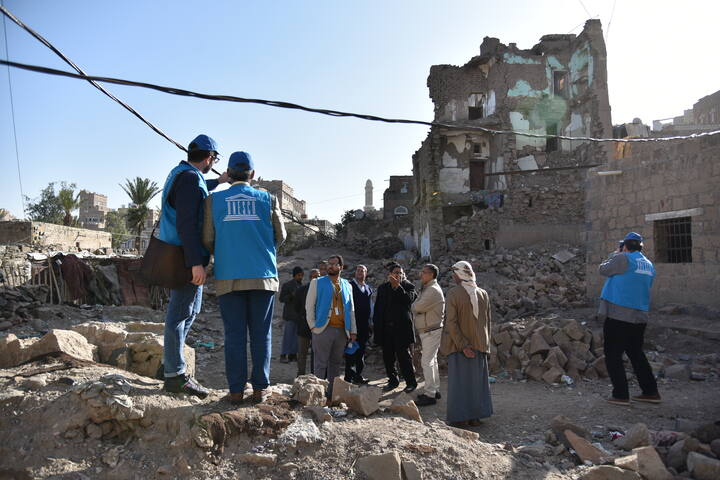Heritage Structures are an integral part of the urban or rural and urban fabric that help in interpreting the culture, tradition, and lifestyle of a society. It acts as an extension to the identity of a place that gives a sense of belonging while sometimes being a juxtaposition to modernity. Conservation of heritage is more than preserving buildings; it is about documenting and sustaining the architectural marvels from the past while making them relevant for the future. The sense of urgency for heritage conservation can be understood in the theme of World Heritage day 2021- “Complex Pasts: Diverse Futures”. The theme urges people across the globe to promote heritage conservation as a necessity by dropping religious barriers and supporting solidarity.
After exhaustive research of the heritage building is completed, the process of heritage conservation is documentation. It is a prerequisite for any conservation project. Documentation involves keeping a written, graphic, and visual record of the heritage structure. As systemized and guided as it may sound, the process of heritage documentation is intense and rigorous. For this purpose, manual tools and techniques have lent significant help over the course of time. However, the traditional methods of heritage documentation are labour-intensive. And, with the advancement in technology, digital ways of documentation have surfaced. While it is certain that technology would replace manual methods, both ways of documentation have to be weighed on their accuracy and costs.
Selecting the Right Documentation Approach
Heritage documentation is a challenging task that involves analyzing as an integral skill. In order to qualify a heritage structure for the next stage of the conservation process, that is detailed documentation, the Conservation Professional(s)/Conservation Architect(s), one has to evaluate them on the basis of certain preset parameters. Accessibility is one of the primary factors that govern the documentation method. If the heritage structure is in a dilapidated condition and unsafe for habitation, it is advisable to consider the digital method. Project scale is yet another parameter to consider as in the case of large-scale projects, it is difficult to maintain uniformity and quality of the drawings. However, for projects of a smaller scale, manual documentation is a preferable choice.
The involvement of time and money in both methods depends on a variety of factors such as skilled labour, the scale of the project, and the time at your disposal. While the manual method consumes more time and money during the documentation process, the digital method seeks more time and money in the post-documentation process of drawing generation. In the case of conducting documentation post-disaster, the digital approach is a viable documentation solution and does not risk human life. The precision of documentation is better in a digital manner, as technology makes it easier to achieve accuracy.
Tech-Integrated Ways of Documentation

Technology offers many unique ways of modern heritage documentation. The first method is the Photogrammetry method, which helps in determining mathematical measures and 3D geometric data by imagery overlapping. Drones can be considered as an extension of this method, as they click aerial views and reach areas where the human approach is difficult. The second is the 3D Laser Scanning method. The latter is an approach that is widely used for surveying industrial projects.
Light Detection and Ranging (LiDAR) is a technology that measures distance with a ray of light. The distance between the illuminated surface and the light source is analyzed through a laser. Geographic Information System (GIS) mapping is another successful way of heritage documentation. While many consider it as an efficient tool only for understanding terrains, GIS Mapping is equally effective in heritage documentation. All these methods are used in combination to provide the best possible results for project documentation.
Organizations in India such as Indian National Trust for Art and Cultural Heritage (INTACH) and Aga Khan Trust For Culture (AKTC) are leading the way forward for heritage documentation and conservation. They aim to lead heritage awareness and conservation by working in various fields of art, architecture, culture, and education.

The Urban Renewal Initiative of the Nizamuddin Basti, Delhi undertaken by the AKTC since 2007 is an example of tech-driven heritage documentation. They used a combination of LiDAR and photogrammetry to generate precise high quality, detailed, and colour-accurate models of the Nizamuddin area. Such use of laser beams for heritage documentation is the first-of-its-kind attempt in India. The heritage precinct of Nizamuddin Basti included significant historic structures such as the Humayun’s mausoleum and garden, Nila Gumbad, Chausath Khamba, Isa Khan’s garden, and mausoleum, and all buildings in the Nizamuddin Dargah Complex.
All the buildings in Dargah Complex were documented with LiDAR and transferred to the software AutoCAD by Autodesk for quantifiable documentation. ReCap (Reality Capture) is software by Autodesk that assists in interpreting laser-scanned heritage documentation. Once transferred to the computer, precise 2D and 3D drawings are demonstrated to shape the architectural features of the heritage structure. The LiDAR scanning method is so precise that it provides a detailed building assessment of structural stability and material deterioration.

The documentation and conservation initiative by AKTC restored the architectural integrity of Humayun’s Tomb and its attached structures, including the gateways, pavilions, and enclosure walls. The grandeur of Mughal architecture that the precinct represents has been uncovered, conserved, restored. Likewise, large-scale works have been undertaken to abate the accelerated deterioration that had begun because of past repairs with modern materials.
The impact of the Nizamuddin Urban Renewal Initiative on the urban community is such that it has helped revive traditional craftsmanship, created livelihood opportunities, revived lost craft techniques, and encourage conservation training. By restoring the setting of the heritage precinct, the initiative has enhanced the socio-cultural fabric of the area.
Technology encourages collaboration and dependability on the digital medium. It has made it easier to document and conserve heritage localities. Such conservation work helps in boosting heritage tourism and eventually contributes to the growth of the country’s economy. Viewing heritage conservation through the lens of socio-economic development makes it an engaging community activity that serves the purpose of “Complex Pasts: Diverse Future.”
Sources:
- World Heritage -Why preserve, conserve and protect?
- NEW TECHNOLOGIES FOR CULTURAL HERITAGE DOCUMENTATION AND CONSERVATION: THE ROLE OF GEOMATICS
- Here’s how technology is helping conservationists to document, restore and maintain our history
- Towards a Systematic Approach to Digital Technologies for Heritage Conservation. Insights from Jordan
- Digital tech advances historic conservation
- Humayun’s Tomb
Disclaimer: The information contained herein have been compiled or arrived at, based upon information obtained in good faith from sources believed to be reliable. The opinions expressed within the content are solely the author’s and can be subject to change. The image featured in this article is only for illustration purposes. If you wish the article to be removed or edited, please send an email to editor@biltrax.com
Discover more from Biltrax Media, A Biltrax Group venture
Subscribe to get the latest posts sent to your email.





















